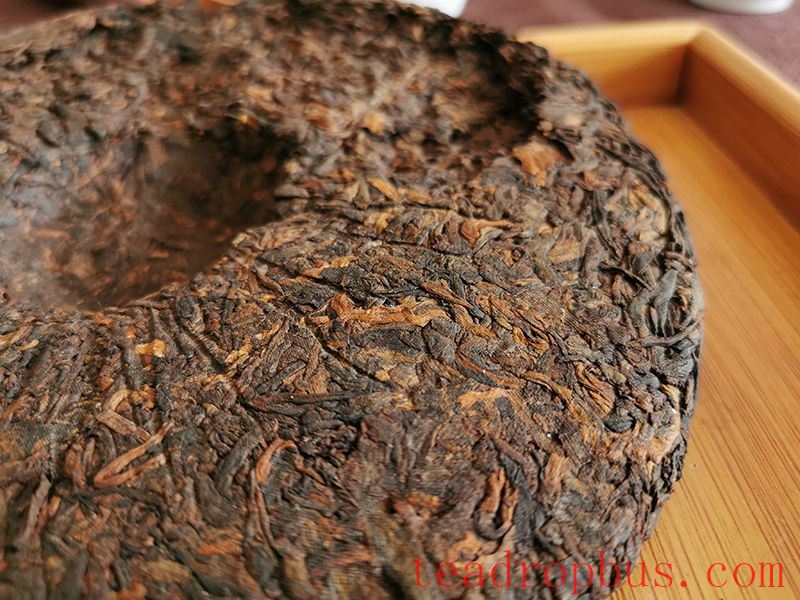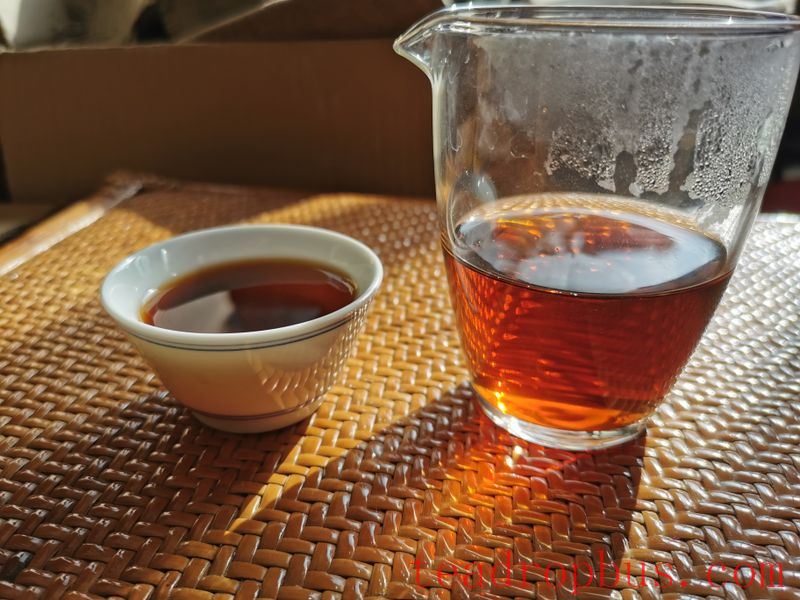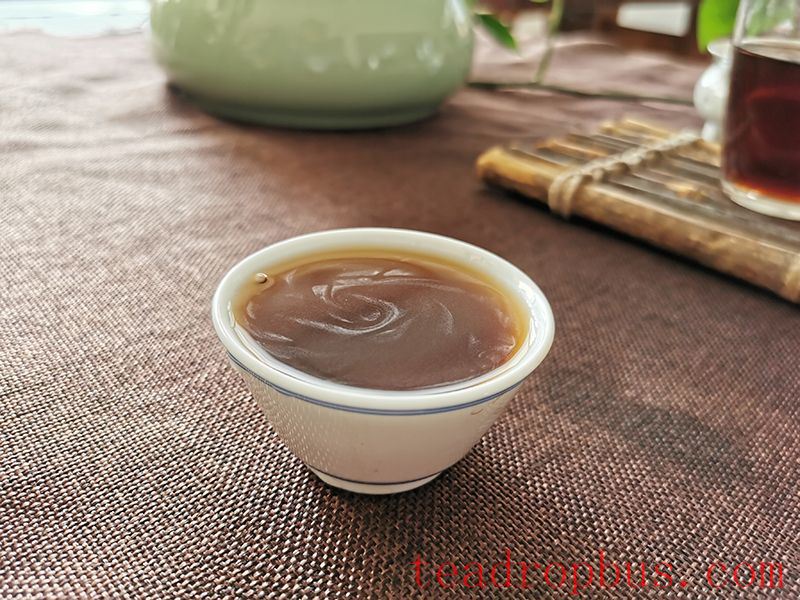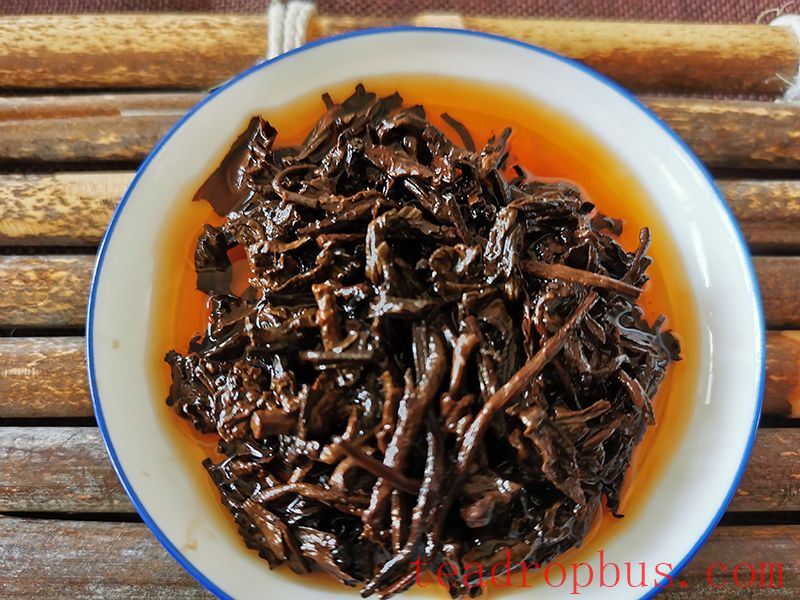Ripe Pu'er Tea is made from Yunnan large-leaf sun-dried Green Tea and processed through a pile fermentation process. This type of tea, known as ripe Pu'er, has a dark brown color, a pure taste, and a unique aged aroma. Due to its mild nature and good Health benefits, it is well loved by the public. So how do you select ripe Pu'er tea for daily drinking?

Selecting Daily Pu'er Ripe Tea:
One: Appearance of Pu'er Tea
Commonly, after pressing, ripe tea is layered with a surface layer of grade 3-4 tea material, commonly referred to as “sprinkling.” It's impossible to determine the quality of the tea just by looking at the surface; one must open it up and observe the clarity of the tea leaves in the cross-section, their color (which should be dark red with golden highlights), and smell the dry tea, which should have a slight caramel aroma. There must be no sour, moldy, or miscellaneous odors.
Two: Observing the Pu'er Tea Infusion
The basic principle for “appreciating the color of Pu'er” is that the infusion of new tea should be a deep, bright red, most visible in a white porcelain cup. Pour a small amount of tea infusion into a cup until the bottom is clearly visible, and a golden ring around the rim is desirable. Using a glass cup to observe the color of the tea infusion, the first thing to look for is its clarity. The standard ripe tea infusion should be a bright red, not black, and the clearer and brighter the tea infusion, the better. Old ripe tea infusions are very clear and have almost no sediment. Next, smell the aroma of the tea infusion; caramel and camphor aromas are superior, and if there is a moldy odor, it should be discarded.

Three: Tasting the Pu'er Tea Infusion
When the tea infusion enters your mouth, let it fully contact the inner walls of your mouth, the tip of your tongue, and the underside of your tongue. Carefully savor the smoothness, sweetness, viscosity, and strength of any bitterness or astringency, then swallow the tea and slowly savor it. If in your tasting you not only taste the smooth sweetness but also a slight astringency that turns refreshing, a slight bitterness that returns to a sweet aftertaste, and a slight warmth in your body, this means that the ripe tea you are drinking is undoubtedly a rare and fine tea.
Excluding considerations such as brand, region, appearance, and the aroma of the dry tea. Whether a tea is good and suitable for you must be determined by trying it. The feeling in your mouth, the persistence of the return to sweetness and saliva stimulation, can all be used to make an initial judgment on its quality. Of course, price factors must also be considered. Good ripe Pu'er tea will not have unpleasant or uncomfortable odors, no moldy smells, and even no aged odors. What it should have is a light pile odor. If there is no pile odor and instead a light caramel aroma, and the tea feels slightly smooth like rice soup when drunk, it is a high-quality product.

Four: The Aftertaste of Pu'er Tea
Pu'er teas of different vintages will certainly have different “sweetness levels.” This is because the production process of Pu'er tea differs from ordinary teas, and the enzymes in the tea leaves remain active. During the storage process, these enzymes react with oxygen in the air through an oxygen-promoted enzymatic reaction. This reaction gradually breaks down some water-insoluble elements in the tea into water-soluble components, such as the conversion of starch into Sugar. The production of ripe Pu'er tea involves accelerating this oxygen-promoted enzymatic reaction, allowing us to enjoy the benefits of “aging” early, but it also has unavoidable drawbacks, one of which is the creation of a pile odor.
As ripe tea ages, the pile odor gradually dissipates (the oxygen-promoted enzymatic reaction continues), and at this point, without the pile odor, the sweetness increases, making the tea more enjoyable. If newly produced ripe tea can achieve almost no pile odor, this indicates that the production process was well executed and is one of the criteria for determining a good ripe tea.

Currently, the Pu'er tea market is not yet mature, and there are few tea merchants capable of discerning the quality of Pu'er tea. Many tea sellers cannot distinguish the true quality of the tea. Driven by profit, some pass off old brands and grade teas, and there are increasingly more so-called vintage Pu'er teas claimed to be 20, 30, or even 50 to 60 years old. Some tea merchants store their tea in damp, dark environments to accelerate aging, artificially adding water, which often leads to moldy and spoiled tea. Once the tea has rapidly deteriorated, they dry the tea cakes, thus obtaining “wet-storage tea” that resembles aged Pu'er within a short period. If it doesn't have a moldy smell and the tea infusion is a reddish-brown with no off-flavors, feel free to enjoy it.